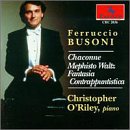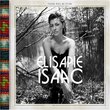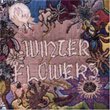| All Artists: Franz Liszt, Ferruccio Busoni, Christopher O'Riley Title: Busoni: Chaconne; Mephisto Waltz; Fantasia; Contrappuntistica Members Wishing: 1 Total Copies: 0 Label: Centaur Release Date: 9/1/1993 Genre: Classical Styles: Forms & Genres, Fantasies, Historical Periods, Modern, 20th, & 21st Century Number of Discs: 1 SwapaCD Credits: 1 UPCs: 044747203621, 750582972133 |
Search - Franz Liszt, Ferruccio Busoni, Christopher O'Riley :: Busoni: Chaconne; Mephisto Waltz; Fantasia; Contrappuntistica
 | Franz Liszt, Ferruccio Busoni, Christopher O'Riley Busoni: Chaconne; Mephisto Waltz; Fantasia; Contrappuntistica Genre: Classical
|
Larger Image |
CD DetailsSimilar CDs
|
CD ReviewsWell played,high energy and overall vision scarecrow | Chicago, Illinois United States | 12/14/2001 (5 out of 5 stars) "Busoni today remains an important transitional figure, that from late Listz,those refined simple works Listz wrote in his final years where focused pianistic timbre was his utopia at the end.But also Busoni saw the profound spectrum of Listz, his seemingly endless excursions into ever creative pathway of music. Listz the purveyor of materials stretching across the depth of music history. This Faustian approach can kill creativity as it also selectively imparts power,success,and subversion.Busoni's achievement was to further complete these creative implications, these strains creatively taking incredible chances with his works, which is why we tend to see an apparent uneveness, and incompletedness of his creative lifeworld. This with the fact that Busoni as Listz, tried to say something in every genre, to his advantage and disadvantage.
The art of the transcription was one pathway began by Listz, with the numerous, many times vacuous opera transcriptions for piano solo. These are/were a little more than written out phantasmagoric improvisations. Busoni now with more discipline within this Faustian context summoned the focus on Bach.This brought this art now to another profound level.The "Fantasia contrappuntistica"(hereafter Fc) has a powerful structure,where you sense the twofold functional role of on-going structural agenda yet maintaning the improvisatory high energy freedom. The "Chaconne" here also exhibits those features, although much more compact. The "Fc" I would not quite label as a symphonic invention, for the post-romantic piano for Busoni struke upon new structural dimensions here. The utilization of three "fugues",and three "variations" makes for exciting pianism, textural displays, the simple idea,chordal inversions, rendered simultaneously with the furioso complex are pitted against/together with each other. Here the "Fuga I" introduces the first subject of the "Contrapunctus XIX" from Bach's "Art of Fugue" which he never completed.Busoni in 1910 had contemplated completing this work.This largely instigated by Bernard Ziehn, a German born music theorist based in Chicago. He revealed to Busoni examples on how all four fugal subjects of Bach's unfinished fugue could be combined according symmetrical inversions.In terms of pianism and timbre, "Fc" has a forbidding vocabulary;trilled left hand octaves in "Fuga III". And when trills are played as Claudio Arrau has remarked you cannot make them sound as the dinner bell, tremoli, trills must have the profundity of conviction. In retrospect we see Busoni was searching for new timbral possibilities.I've heard Kissin and Michelangeli play the "Chaconne" and both have new insights. Naturally Michelangeli has a heavenly mature sense of the severity of the work, whereas Kissin brings forth the works high energy. Here O'Riley doesn't quite ascend to Michelangeli's visionary sense of seeing the entire work at once,but he has some nice moments.O'Riley in the "Fc" I thought was too bright and unclear when the vilence begins,as the Fugues. Still O'Riley brings an overwhelming shape to the mastodonic dimensions of "Fc"." |

 Track Listings (3) - Disc #1
Track Listings (3) - Disc #1

